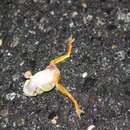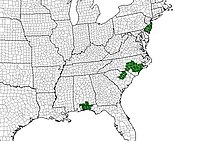ar
الأسماء في صفحات التنقل


They are known as pine barrens tree frogs because they are found only in the Pine Barrens forests of the eastern United States from New Jersey to South Carolina. (Conant, 1975)
Hyla andersonii are considered an endangered species. Recently, many pools which provided a habitat for Hyla andersonii have been destroyed for the sake of development. The pools have been drained or dried up and they no longer have a place to live. The only way to preserve this species is to protect the area of the Pine Barrens on the eastern coast of the U.S. Another endangerment is DDT. There now remains only three main concentrations of the Pine Barrens Tree Frog, the largest of which is in New Jersey. (Beebee, T.J.C.)
US Federal List: endangered
IUCN Red List of Threatened Species: near threatened
Development - Life Cycle: metamorphosis
Adult pine barrens tree frogs are predatory. In the larval stage tree frogs eat vegetation or algae in the water. Adults catch flies, small slugs, snails, beetles, butterflies or moths. They catch these organisms with their tongue. While the tadpole has reduced teeth, the teeth grow slightly when an adult. (Beebee, 1985)
Hyla andersonii range from southern New Jersey to South Carolina. On a few occaisions, however, they have been seen as far south as the Florida panhandle and as far west as Alabama.
(Conant, 1975)
Biogeographic Regions: nearctic (Native )
Hyla andersonii reside in pools during part of the year, but when those dry up during the warmer summer months, they live on the damp soil in dark shaded areas of raspberry bushes and other brush. Whereas tadpoles swim in pools or ponds, adults are terrestrial, but live near water. Research suggests that that low pH in natural ponds limits Hyla andersonii to acidic ponds. (Grzmek, 1970; Pehek, 1995; Underhill, 1951; Wright & Allen, 1961)
Terrestrial Biomes: forest
Hyla andersonii vary in size. Adult females are between 30-41 mm in length and adult males are between 38-47mm in length. Hyla andersoni are bright green with plum or lavender stripes bordered by white running along their sides. On the inner femur and on the groin there are patches of orange, which are concealed when they are in resting/sitting position. The ventral surface is white and the dorsal surface entirely green. This coloration acts to comouflage them in vegetation. On females there are also white bordered patches of darker green on either side of the throat and the mouth is edged in white. Their feet have sticky pads on each finger in order to grip tree bark or leaves. (Conant, 1975)
Other Physical Features: ectothermic ; bilateral symmetry
Hyla andersonii reproduce sexually. Matin occurs during the spring, usually from May 1-July 20, the latter half of the season occurring mostly in the southern areas of North and South Carolina. Age at sexual maturity is 2 to 3 years old. Ovulation is induced by males while mounting the female from the back. Males release sperm directly onto the eggs as they are released by females. (Conant, 1975; Beebee 1985)
Key Reproductive Features: gonochoric/gonochoristic/dioecious (sexes separate)
The Pine Barrens tree frog[3] (Dryophytes andersonii) is a species of New World tree frog. It is becoming rare due to habitat loss.
Dryophytes andersonii is about 2.8–4.3 centimetres (1.1–1.7 in) long, snout-to-vent, as an adult. Members of the species are predominantly emerald green. The green coloration is bordered by a white stripe, which separates it from a later plum band that extends downwards to cover the belly. The hidden surfaces of their legs are orange to yellow.[4] The belly is covered in white areolae. The toes are partially webbed, while the fingers are free. The pads of both fingers and toes are small.[5]
The key to distinguishing the Pine Barrens tree frog from the similar-appearing American green tree frog (D. cinerea) is the white-bordered lavender stripe on each side of the body in the Pine Barrens tree frog. D. cinerea has only a white stripe in this location.
Dryophytes andersonii are primarily found near temporary still or slow waters dominated by shrubs or herbaceous plants. Permanent bodies of water that are home to fish contain fewer and more isolated frogs. Their preferred natural habitats include wet areas in pitch pine forests, intermittent streams and ponds, stream backwaters, Sphagnum bogs, and Atlantic white cedar swamps. They are also found alongside artificial bodies of water such as cranberry bogs, water-filled ruts created by vehicles, flooded borrow pits, and ditches. Adults are primarily found in waterside vegetation, but may be encountered on the ground.[4]
D. andersonii prefer to reproduce in isolated, shallow, acidic ponds. The ideal pH level for D. andersonii eggs is between 3.74 and 4.69. The eggs are laid in May and June; the tadpoles metamorphose into adults in July and August. Eggs are laid singly, and are approximately 1.2–1.4 millimetres (0.047–0.055 in) in diameter.[4][5]
Calling begins at the end of April and can continue into August. Adults remain within 70 metres (230 ft) of their breeding sites throughout the breeding season, although individuals have been documented as far as 100 metres (330 ft). Towards the end of the season, they disperse father away from their breeding sites. The species' comparatively late breeding season, combined with its preference for temporary water sources, makes it vulnerable to droughts and changes in water levels.[4]

Dryophytes andersonii primarily inhabits the Atlantic Coastal Plain.[5] Due to the limited extent of suitable habitats, the species is currently distributed in three disjunct areas in the southeastern United States: the New Jersey Pine Barrens; the Sandhills of North and South Carolina; and the Florida panhandle and southern Alabama. The New Jersey populations are the largest currently recorded.[6] Although one specimen of D. andersonii is known from Richmond County Georgia, a population is not known to currently exist there.[5][6]
Dryophytes andersonii is the state frog of North Carolina. It was selected through a poll organized by the North Carolina Herpetological Society, in which the Pine Barrens tree frog was chosen alongside the marbled salamander.[7][8]
Dryophytes andersonii was listed as endangered by the US Fish and Wildlife Service between 1977 and 1983, when additional populations were found in Florida.[9] The IUCN has classified it as Near Threatened as of 1996.[1]
Pine Barrens tree frogs are rarely encountered in sites where nonnative amphibians, such as bullfrogs, and nonnative fish are present, suggesting that they are poor competitors. As a consequence of this, D. andersonii populations found in or near developed and agricultural areas are believed to be the most at risk due to the greater presence of nonnative species there.[4]
The Pine Barrens tree frog is currently listed as Threatened in the state of New Jersey.[4]
The Pine Barrens tree frog was featured in a series of prints by artist Andy Warhol. In 1983, the artist was commissioned to create a portfolio of ten endangered species to raise environmental awareness and included was D. andersonii.[10]
The Pine Barrens tree frog (Dryophytes andersonii) is a species of New World tree frog. It is becoming rare due to habitat loss.
La rana arbórea del yermo de Pinos (Hyla andersonii o Dryophytes andersonii) es una especie de anfibios de la familia Hylidae. Habita en Estados Unidos.[1] Se consideró en peligro de extinción hasta el hallazgo de nuevas poblaciones en Florida.[2][3]
Miden de 25 a 76 mm. Son de color verde con bandas anchas oscuras. A menudo tienen marcas naranjas o doradas en las partes ocultas por las patas.[4]
Se alimentan de invertebrados; saltamontes, grillos, arañas, hormigas, moscas y otros insectos componen la dieta de las ranas arborícolas adultas de esta especie. Los renacuajos consumen algas, invertebrados microscópicos y vegetación acuática.[cita requerida]
La rana arbórea del yermo de Pinos (Hyla andersonii o Dryophytes andersonii) es una especie de anfibios de la familia Hylidae. Habita en Estados Unidos. Se consideró en peligro de extinción hasta el hallazgo de nuevas poblaciones en Florida.
Miden de 25 a 76 mm. Son de color verde con bandas anchas oscuras. A menudo tienen marcas naranjas o doradas en las partes ocultas por las patas.
Hyla andersonii Hyla generoko animalia da. Anfibioen barruko Hylidae familian sailkatuta dago, Anura ordenan.
Dryophytes andersonii est une espèce d'amphibiens de la famille des Hylidae[1].
Cette espèce est endémique des États-Unis. Elle se rencontre de manière discontinue, dans trois zones disjointes, dans les États de l'Est du pays :
Sa répartition actuelle pourrait être les vestiges d'une répartition beaucoup plus étendue dans le passé[2].
Cette espèce est nommée en référence à son lieu de découverte, le comté d'Anderson[3].
Dryophytes andersonii est une espèce d'amphibiens de la famille des Hylidae.
Hyla andersonii é uma espécie de anfíbio anuro da família Hylidae.[2][3] É considerada quase ameaçada pela Lista Vermelha da UICN.[1] Está presente em Estados Unidos.[3]
Hyla andersonii é uma espécie de anfíbio anuro da família Hylidae. É considerada quase ameaçada pela Lista Vermelha da UICN. Está presente em Estados Unidos.